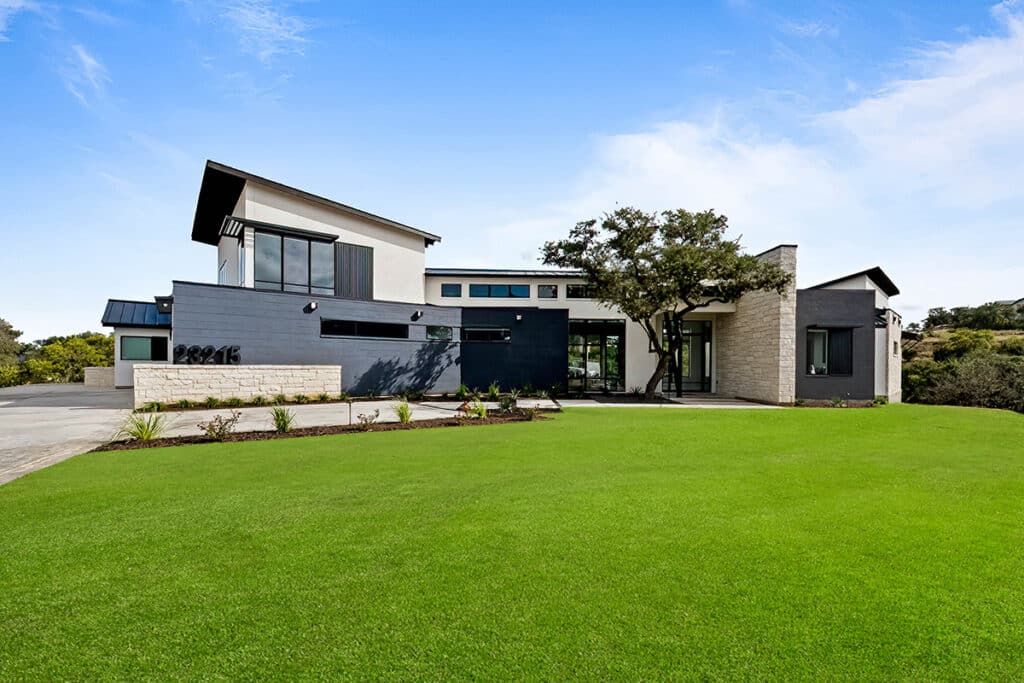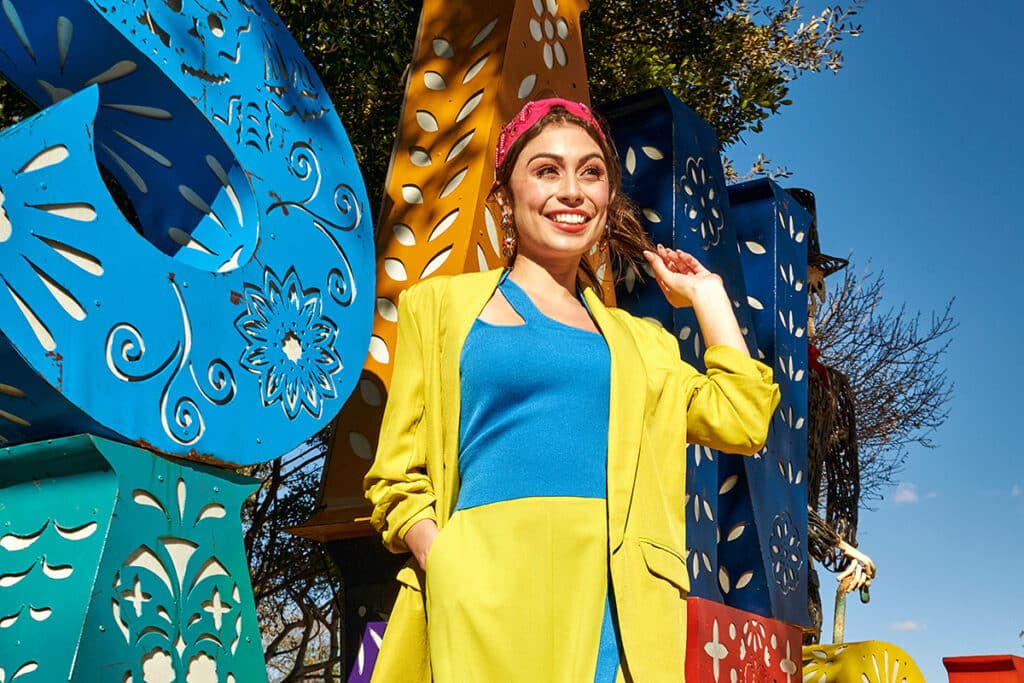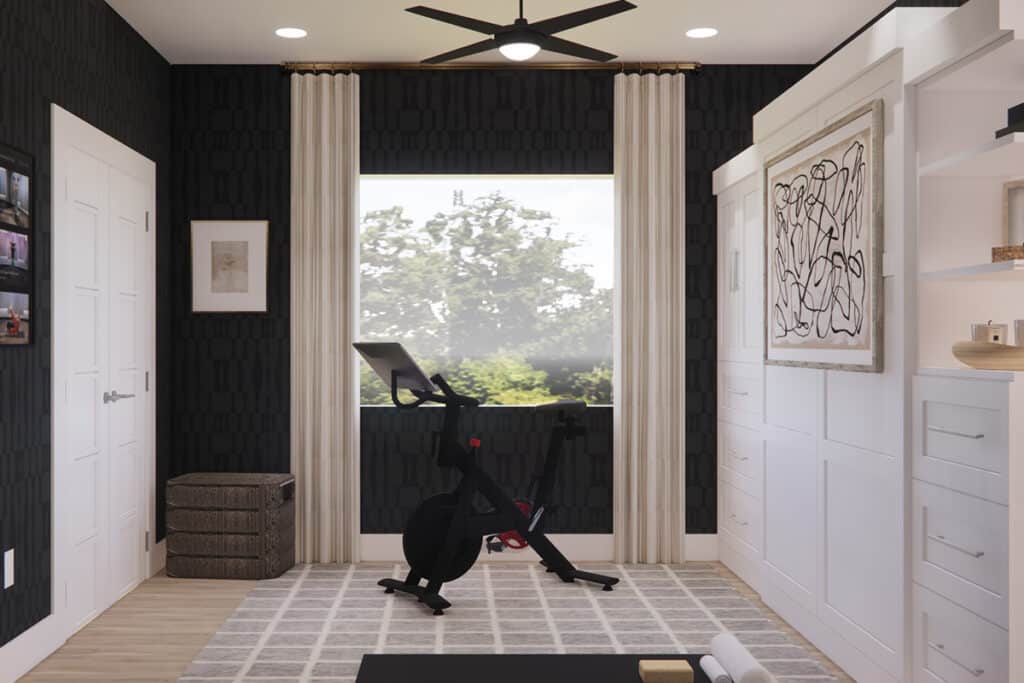The circa-1970s contemporary house J. Cary and Carolyn Barton purchased in 1991 is not your typical Brady Bunch split-level suburban dwelling. Set high on a hill in an inviting tree-shaded north San Antonio neighborhood, the spacious multi-level home holds unexpected stairwells followed by fascinating ups and downs, twists and turns. Corridors lead to conventional spaces, but there is exhilaration in getting to those spaces and sheer delight upon arrival.
The home is a virtual fiesta of brilliant hues on ceiling and walls — colors that dazzle the eye and quicken the pulse. They range from teal, yellow, lime green, royal blue, red and purple to the more subdued terra cotta of the D’Hanis tile flooring.
The décor throughout gives a definitive nod to all things south of the border, a “curtsy” to family heirlooms and a full “court bow” to the arts — from the serious to the serendipitous, including the folk art of Mexico.
More than a few visitors to the Barton residence have observed an O’Neil Ford quality therein. Carolyn says the truth of the matter is not known, but there remains the possibility it was designed by someone associated with or influenced by the renowned San Antonio architect.
She adds there have been those who declared the front door to be “Ford-like.” Interestingly, our own San Antonio Woman photographer, Al Rendon, voiced the same opinion, declaring it similar to the work of Lynn Ford, the architect’s craftsman brother. The solid-core door is applied at both sides with massive bronze plaques in a contemporary geometric design.
(Paula Allen, San Antonio Woman freelance contributor and San Antonio Express-News columnist, lends credence to the theory. She describes Lynn Ford’s work as featuring “lots of geometric shapes, indigenous materials … simple forms that still carry a lot of decorative punch” and complementing his brother’s architecture.)
Beyond the exquisite door, an immense painting of an angel by Alberto Mijangos greets the visitor. A large Oaxacan nicho rests on a console below.
“My home is connected to my love for Mexico,” explains Carolyn. ”I lived there two years with my three daughters and love the colors, atmosphere and textures of that country.” Additionally, she has long operated an import business, Tres Niñas Un Niño, selling primarily to decorators.
The home has seen extensive renovation to bring it up to date structurally as well as aesthetically. Overseeing myriad projects is Linda Ricks, ASID, owner of Collaborations, Inc., an interior design service. She mentions a real plus was found in the homeowner’s sense of direction for the home and her extensive collection of accessories, ordinarily a major interior design expense. “And Carolyn has a story to tell about every item,” she says with a smile.
Ceilings throughout the home are vivid teal, albeit faintly washed with a white glaze, achieving a cloud-like effect. Carolyn confesses, “Someone once said to me,’I don’t think I would let anyone talk me into painting my ceilings that color.'” She laughs, recalling her response. “I told them it was my idea.”
Walls in the huge central living area are brick, now obscured and thickly slathered with plaster to create a “Monterrey texture,” says Linda. Multiple steps were meticulously followed by painters, who precariously treaded scaffolding in the large room to achieve the final dramatic effect — walls of an aged mustard yellow. Gene Porto of Gene Porto Paint Company oversaw all the clever paint effects throughout the home.
Two separate and generous seating areas are found here. Raspberry chenille upholstery is seen on sofas in one area — furniture that once belonged to Carolyn’s mother. The rug beneath is a Shiraz from Bijan Oriental Rugs — the source for all rugs in the home. Other spaces hold elegant Hamadan, Mahal and Kazak carpets. A portrait of Carolyn in a crimson dress complements the room. The artist is Dick Turner, whose paintings also appear elsewhere in the home.
Bookcases fronting the living room wall are topped with a succession of Oaxacan terra cotta missions. Floor-to-ceiling rectangular windows nearby have been reconfigured with graceful arches to further evoke the Latin feeling. Carpentry throughout the home, including window arches, is by Richard Ricks, the interior designer’s son. The two worked in tandem to design and build from scratch the living room’s massive mantel of birch with poplar molding. The various components were assembled on site for Carolyn until the desired effect was achieved.
A treasured sculpture of the Holy Family adorns the mantel. “I was in a frame store and saw it,” relates Carolyn. “I just knew I could not afford it when I saw it was by Brother Cletus.” Not to worry — as luck or destiny would have it, one figure’s head had come off and been glued back into place. Consequently, the art went for less than one would have dreamed. “It still falls off once in a while when it’s moved,” laments Carolyn. Glue once more comes to the rescue, and all is well.
The fireplace serves the second seating area in the central living space. There, a sofa is splashed with a collection of colorful pillows created by women on a ranch near San Miguel de Allende. A Oaxacan hand-painted trunk sits between sofa and wingback chair upholstered in an Ikat flame stitch fabric. Illumining the space is a massive chandelier. Though from Oaxaca, it is Moroccan in design. Variations of the fixture are located throughout the home.
A collection of ex voto reproductions by Oaxacan artisanos is exhibited on a nearby wall. Ex votos are small paintings traditionally created on tin, zinc, paper or wood by Mexican peasants to show how a calamity or problem in their lives was miraculously resolved. The small visual narratives are left at church altars as an expression of thanks to God and represent real-life events, from the loss of a cow to the most grave and incurable illness.
An informal living space on a second level carries a seating area served by two sofas, one in Jacobean floral design, the other in white linen. A casual, albeit elegant, dining space and royal blue bar area are nearby. A honey-finish console conceals an entertainment center and holds a tripod displaying the ceramic tile image of Nuestra Senora de San Juan de los Lagos.
Hanging above a primitive cabinet is a large photograph of Emiliano Zapata, Mexican guerilla leader of the early 20th century. “I found it in a Mexico City flea market in 1984, under a pile of stuff,” says Carolyn, “and I fished it out for the quality I saw.” There are a lot of Zapata photographs around, she states, but few match the superiority of this treasure.
The adjoining kitchen, beyond a granite bar, is the work of Richard. Custom maple cabinetry abounds with a honey finish as smooth as glass. Drawers open to full extension, and no pulls are needed to access drawers or cabinets. Gold ceramic tile counter tops are illumined by two stained glass chandeliers by Gallery of Lighting, contractors for all new light fixtures in the home.
Massive screen print panels in floral design by Heriberto Robles hang high on the kitchen wall. An adjacent niche towers over the kitchen and spills with colorful baskets. Small trunks here and there repeat the screen print, while Robles’ original work is displayed in a bookcase. A butler’s pantry separates the kitchen from the formal dining room, elegantly appointed with something of a contrast for the home —French country table and chairs. The master bedroom on an upper level is swathed in burgundy fabrics and wrapped by walls of a “Red River” hue.
During renovation, the room’s Sheetrock ceiling was removed to create a vaulted ceiling and, voila, there appeared a window which could be seen from the yard but which had been obscured within by the low ceiling.
Cary, a prominent real estate attorney, has a study nearby which overlooks the informal living/dining space. Carolyn’s studio and cozy guest quarters are in a separate wing on lower levels. Stairways to all the various levels are ceramic tile replicating the D’Hanis tile flooring. Mexican tiles front the steps and were meticulously chosen for each step by Carolyn and Linda. Tile work was completed by W.R. Jones Tile. Quality Welding and Fabrication was responsible for railings and ironwork throughout, appointments important to the home’s Latin ambiance.
An expanse of glass doors lead to the backyard, which rises beyond the pool to near the home’s second level. It is accessed via a romantic flagstone patio and walkway created by Raul Perales. Asiatic jasmine covers a lower wall near the pool—a wall that reaches to the base of the upper walkway. Ivy, interspersed with seasonal flowers, forms the backdrop at the upper level adjacent to the walkway. Massive Oaxacan chandeliers, similar to those within the home, hang over the pool and are fitted with large pillar candles, offering a stunning fairytale atmosphere by evening.
Photographer: Al Rendon




